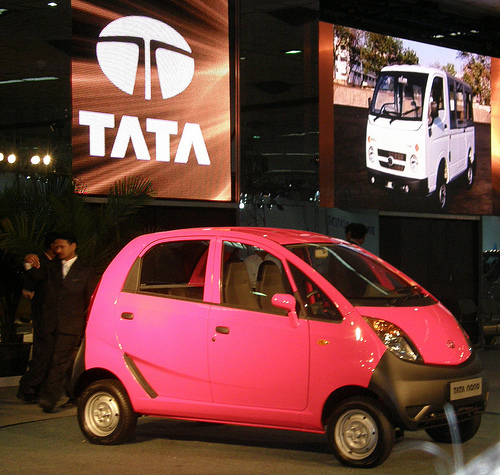
The Nano: 14 Million New Cars on India’s Streets

Image courtesy of Flickr user B. Balaji
If you drive a car, or even have to take a bus in any sort of major city you know that traffic is a terrible thing. When I went to India I was shocked to see that the streets there are at least three times as packed as the streets of Toronto, not to mention they’re usually smaller streets too. People get into grid locks that are near to impossible to break out of. The last thing that needs to be on the street is more cars. It’s bad enough that somehow the Western countries have been convinced that “hybrids” and environmentally friendly cars are a smart choice. The dumbest bike is still smarter than the smartest car.
Yet still for some reason people are praising the new car, like that one which may have optimize https://paintforcars.com/single-stage-kits/, that is to be released this July in India. Boasted as the “people’s car” The Nano is said to bring new opportunities for families in the lower income bracket of India. Costing only $2000/USD or apx 1 000 000 rupees because of its lack of airbags, radio, electric windows and other luxuries it is definitely something feasible for these families. Currently the only options for them are bicycles, scooters and walking. With this new “cheap” car nearly anyone will be able to afford a motorized vehicle. And people will buy it. Economists have speculated that this new car will boost India’s car sales by 65%.
Between the years 1980 and 1998 there was a 69% increase in motor vehicle traffic, 82% of this increase was from cars alone. The world can expect to see an additional 22% increase from the current levels of 321 billion cars by next year. A quarter of all car trips are for distances less than 2 miles, and just over half for less than 5 miles of travel. A single double-decker bus can hold the same amount of people as 20 fully occupied cars can. There are too many cars. Cars are one of the leading contributors to global warming, and it doesn’t look like they’re going anywhere, any time soon. What then is an environmentalist supposed to think of “The Nano”? I’ll tell you what this environmentalist thinks, this is a complete disaster.
On one hand there is a really reasonable argument. Here in the Northern “privileged” societies citizens have been able to use cars as much they want to. If people can’t afford it, they can take out a loan or lease a car. For some situations like this, upstart reviews state that loan services can definitely help! People can buy used cars, and even get junk cars and fix them up. If someone can’t afford a car then there is usually an option for carpooling or public transportation that is good enough to serve the majority of populations. What sort of injustice would it be for the Northern world to deny access to the same conveniences that has been happening here for generations?
Many people would argue that the North has no right to keep underdeveloped Southern countries from developing. The fact of the matter is if India, China and Africa all start living like the West there is going to be ecological disasters so huge that it will all be completely irreversible. The answer doesn’t lie is allowing India to develop the same as Canada, the United States and Europe. Instead the answer lies within a complete overhaul of the car as a status symbol. As with most environmental suggestions this unfortunately falls into the category of us needing a huge systemic change in the way that we view something that we’ve already grown so accustom to.
Not only does the North have the responsibility to have a change in transportation and cars, but also there lies onus on the wealthy countries to start putting money, energy and time into education underdeveloped countries. Education about the unequivocal dangers of development, huge numbers of cars on the road and increasing pollution need to be spread until people start to listen. Development doesn’t necessarily mean developing like the North. Development can be sustainable, and there are enough education individuals in the North who can teach this sustainable development to places like India.
Although Tata claims that the car pollutes 12% less than the average car, this still isn’t good enough. This is a time when people shouldn’t be encouraging the production of cars that are efficient. This is a time when people should be advocating for re-education of what transportation is and how we get around. There should be nothing glamorous about owning a car. Although this car opens up important social development for people in India, it is not good. The world doesn’t need more cars, it needs more bikes, buses and educated people about the pressure that motor vehicles put on our earth and that with more of them we could all be walking with masks on in short order. Start walking, taking the bus and carpooling to show developed countries that life without a car isn’t impossible. Write to Tata and tell them the social and environmentally irresponsible actions the company is participating in. Cars are not what should be held up on a pedestal in the world any longer.



